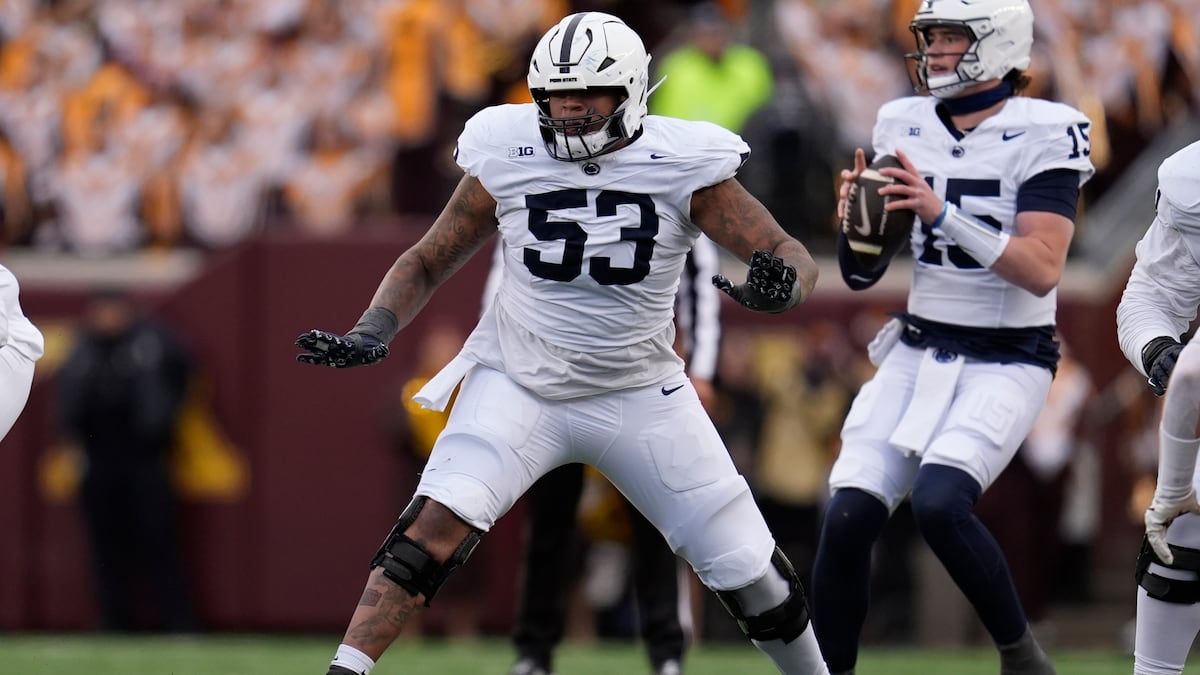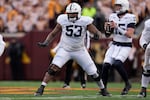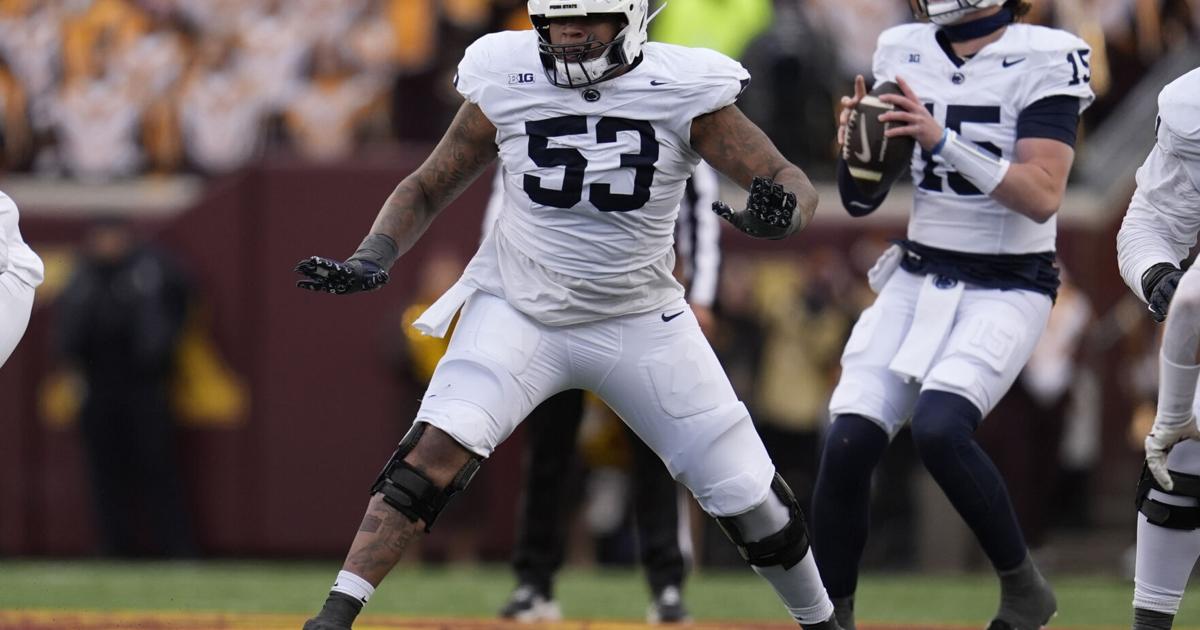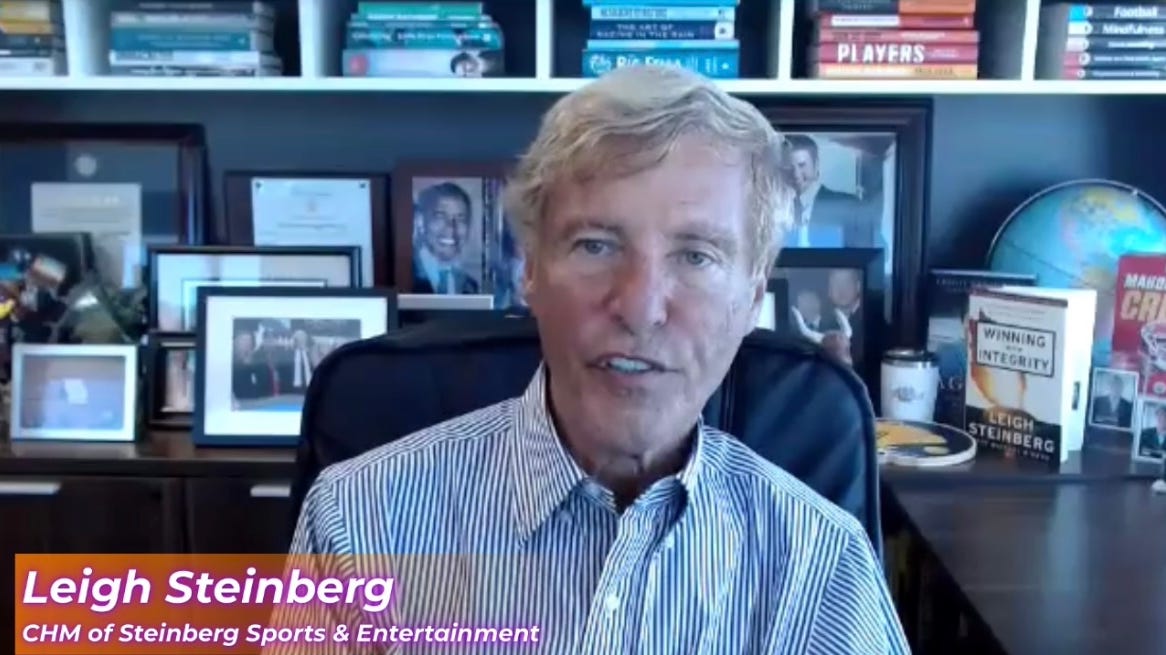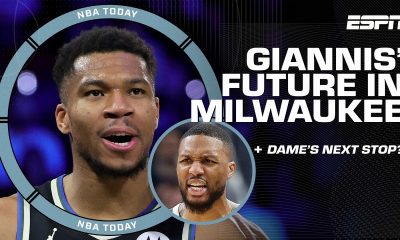WASHINGTON (AP) — President Donald Trump on Thursday signed an executive order mandating that federal authorities clarify whether college athletes can be considered employees of the schools they play for in an attempt to create clearer national standards in the NCAA’s name, image and likeness era.
Trump directed the secretary of labor and the National Labor Relations Board to clarify the status of collegiate athletes through guidance or rules “that will maximize the educational benefits and opportunities provided by higher education institutions through athletics.” The order does not provide or suggest specifics on the controversial topic of college athlete employment.
kAm%96 >@G6 4@>6D 27E6C >@?E9D @7 DA64F=2E:@? 23@FE H96E96C %CF>A H:== 6DE23=:D9 2 4@==686 DA@CED 4@>>:DD:@? E@ E24<=6 D@>6 @7 E96 E9@C?J :DDF6D 724:?8 H92E 😀 ?@H 2 >F=E:3:==:@?\5@==2C :?5FDECJ] w6 :?DE625 :DDF65 2? @C56C :?E6?565 E@ 255 D@>6 4@?EC@=D E@ “2? @FE\@7\4@?EC@=[ CF556C=6DD DJDE6> 😕 H9:49 4@>A6E:?8 F?:G6CD:EJ 5@?@CD 6?8286 😕 3:55:?8 H2CD 7@C E96 36DE A=2J6CD[ H9@ 42? 492?86 E62>D 6249 D62D@?]”k^Am
kAm“p3D6?E 8F2C5C2:=D E@ DE@A E96 >25?6DD 2?5 6?DFC6 2 C62D@?23=6[ 32=2?465 FD6 @7 C6D@FC46D 24C@DD 4@==68:2E6 2E9=6E:4 AC@8C2>D E92E AC6D6CG6D E96:C 65F42E:@?2= 2?5 56G6=@A>6?E2= 36?67:ED[ >2?J 4@==686 DA@CED H:== D@@? 462D6 E@ 6I:DE[Q %CF>AVD @C56C D2JD] “xE 😀 4@>>@? D6?D6 E92E 4@==686 DA@CED 2C6 ?@E[ 2?5 D9@F=5 ?@E 36[ AC@76DD:@?2= DA@CED[ 2?5 >J 25>:?:DEC2E:@? H:== E2<6 24E:@? 244@C5:?8=J]”k^Am
kAm%96C6 92D 366? 2 5C2>2E:4 :?4C62D6 😕 >@?6J 7=@H:?8 :?E@ 2?5 2C@F?5 4@==686 2E9=6E:4D 2?5 2 D6?D6 @7 492@D] z6J 4@FCE G:4E@C:6D H@? 3J 2E9=6E6D 2?8CJ E92E E96J H6C6 32CC65 7@C 564256D 7C@> 62C?:?8 :?4@>6 32D65 @? E96:C 46=63C:EJ 2?5 7C@> D92C:?8 😕 E96 3:==:@?D @7 C6G6?F6 E96J 96=A65 86?6C2E6 92G6 8FEE65 E96 2>2E6FC:D> >@56= =@?8 2E E96 962CE @7 4@==686 DA@CED]k^Am
kAmu24:?8 2 8C@H:?8 ?F>36C @7 DE2E6 =2HD F?56C4FEE:?8 :ED 2FE9@C:EJ[ E96 }rpp 😕 yF=J a_a` 4=62C65 E96 H2J 7@C 2E9=6E6D E@ 42D9 😕 H:E9 }x{ 562=D H:E9 3C2?5D 2?5 DA@?D@CD — 562=D ?@H H@CE9 >:==:@?D] %92E 42>6 >6C6 52JD 27E6C 2 k2 9C67lQ9EEADi^^2A?6HD]4@>^2CE:4=6^4@==686\DA@CED\32D<6E32==\7@@E32==\4@==686\32D<6E32==\>6?D\4@==686\32D<6E32==\c`fgfc34bb7_2fh`cdg33c25g5c`cb_dQmh\_ 564:D:@?k^2m 7C@> E96 $FAC6>6 r@FCE E92E 7@F?5 E96 }rpp 42??@E :>A@D6 42AD @? 65F42E:@?\C6=2E65 36?67:ED D49@@=D AC@G:56 E@ E96:C 2E9=6E6D 3642FD6 DF49 =:>:ED G:@=2E6 2?E:ECFDE =2H]k^Am
kAm%96 }rpp’D 6>3C246 @7 }x{ 562=D D6E E96 DE286 7@C k2 9C67lQ9EEADi^^2A?6HD]4@>^2CE:4=6^?422\9@FD6\D6EE=6>6?E\22b`eh_de6g`hc26637bcchdec`346_3Qm2?@E96C >2DD:G6 492?86k^2m E92E E@@< 67764E yF=J `i %96 23:=:EJ @7 D49@@=D E@ 368:? A2J:?8 >:==:@?D @7 5@==2CD E@ E96:C @H? 2E9=6E6D[ FA E@ Sa_]d >:==:@? A6C D49@@= @G6C E96 ?6IE J62C] %96 Sa]g 3:==:@? k2 9C67lQ9EEADi^^2A?6HD]4@>^2CE:4=6^?422\D6EE=6>6?E\3e77dg5ea7hbbdhfgh556`eae7gaf37`Qmw@FD6 D6EE=6>6?Ek^2m D9:7ED 6G6? >@C6 A@H6C E@ 2E9=6E6D[ H9@ 92G6 2=D@ H@? E96 23:=:EJ E@ EC2?D76C 7C@> D49@@= E@ D49@@= H:E9@FE H2:E:?8 E@ A=2J]k^Am
kAmpE q:8 %6? r@?76C6?46 7@@E32== >65:2 52JD 😕 {2D ‘682D[ !FC5F6 4@249 q2CCJ ~5@> H2D 2D<65 23@FE E96 %CF>A @C56C]k^Am
kAm“(6’G6 8@EE6? E@ E96 A@:?E H96C6 8@G6C?>6?E 😀 :?G@=G65] ~3G:@FD=J[ E96C6’D 36=:67 :E ?665D E@ 36 :?G@=G65[Q 96 D2:5] “(6’== 86E :E 2== H@C<65 @FE] %96 82>6’D 366? 2C@F?5 7@C 2 9F?5C65 J62CD 2?5 :E’D 8@:?8 E@ 36 2C@F?5 `__ >@C6]”k^Am
kAm%96 }rpp 92D 366? =@33J:?8 7@C D6G6C2= J62CD 7@C =:>:E65 2?E:ECFDE AC@E64E:@? E@ <66A D@>6 <:?5 @7 4@?EC@= @G6C E9:D ?6H =2?5D42A6 — 2?5 2G@:5 >@C6 4C:AA=:?8 =2HDF:ED — 3FE 2 92?57F= @7 3:==D 92G6 8@?6 ?@H96C6 😕 r@?8C6DD] %CF>AVD @C56C >2<6D ?@ >6?E:@? @7 E92E[ ?@C 5@6D :E C676C E@ 2?J @7 E96 4FCC6?E k2 9C67lQ9EEADi^^2A?6HD]4@>^2CE:4=6^@=J>A:4D\?422\DA@CED\4@?8C6DD\dh5d65_bdfc736`4aa_eb5_5hche63bdQm3:==D 😕 r@?8C6DDk^2m 2:>65 2E 255C6DD:?8 :DDF6D 😕 4@==686 DA@CED]k^Am
kAm}rpp !C6D:56?E r92C=:6 q2<6C 2?5 E96 ?2E:@?VD =2C86DE 4@?76C6?46D 3@E9 :DDF65 DE2E6>6?ED D2J:?8 E96C6 😀 2 4=62C ?665 7@C 7656C2= =68:D=2E:@?]k^Am
kAm“%96 2DD@4:2E:@? 2AAC64:2E6D E96 %CF>A 25>:?:DEC2E:@?’D 7@4FD @? E96 =:76\492?8:?8 @AA@CEF?:E:6D 4@==686 DA@CED AC@G:56D >:==:@?D @7 J@F?8 A6@A=6 2?5 H6 =@@< 7@CH2C5 E@ H@C<:?8 H:E9 DEF56?E\2E9=6E6D[ 2 3:A2CE:D2? 4@2=:E:@? 😕 r@?8C6DD 2?5 E96 %CF>A 25>:?:DEC2E:@?[” D2:5 q2<6C[ H9:=6 E96 4@?76C6?46D D2:5 :E H2D :>A@CE2?E E@ A2DD 2 =2H H:E9 ?2E:@?2= DE2?52C5D 7@C 2E9=6E6D’ }x{ C:89ED 2D D@@? 2D A@DD:3=6]k^Am
kAm%96 `[`__ F?:G6CD:E:6D E92E 4@>AC:D6 E96 }rpp 92G6 :?D:DE65 7@C 564256D E92E 2E9=6E6D 2C6 DEF56?ED H9@ 42??@E 36 4@?D:56C65 2?JE9:?8 =:<6 2 D49@@= 6>A=@J66] $E:==[ D@>6 4@2496D 92G6 C646?E=J DF886DE65 k2 9C67lQ9EEADi^^2A?6HD]4@>^2CE:4=6^9@FD6\D6EE=6>6?E\E6??6DD66\2E9=6E6\32C82:?:?8\6e3a4a3b_2ehb2`b`b5`7_c36g5b_c6hQm4@==64E:G6 32C82:?:?8k^2m 2D 2 A@E6?E:2= D@=FE:@? E@ E96 492@D E96J D66]k^Am
kAmxE 😀 2 4@>A=:42E65 E@A:4i &?:G6CD:E:6D H@F=5 364@>6 C6DA@?D:3=6 7@C A2J:?8 H286D[ 36?67:ED[ 2?5 H@C<6CD’ 4@>A6?D2E:@? 2?5 D49@@=D 2?5 4@?76C6?46D 92G6 :?D:DE65 E96J H:== 7:89E 2?J DF49 >@G6 😕 4@FCE] (9:=6 AC:G2E6 :?DE:EFE:@?D 72== F?56C E96 }2E:@?2= {23@C #6=2E:@?D q@2C5[ AF3=:4 F?:G6CD:E:6D >FDE 7@==@H =23@C =2HD E92E G2CJ 7C@> DE2E6 E@ DE2E6 2?5 :E’D H@CE9 ?@E:?8 E92E G:CEF2==J 6G6CJ DE2E6 😕 E96 $@FE9 92D “C:89E E@ H@C<” =2HD E92E AC6D6?E 492==6?86D 7@C F?:@?D]k^Am
kAm%CF>AVD @C56C 2=D@ik^Am
kAm— r2==D 7@C 255:?8 @C 2E =62DE AC6D6CG:?8 2E9=6E:4 D49@=2CD9:AD 2?5 C@DE6C DA@ED 7@C ?@?\C6G6?F6 DA@CED[ H9:49 2C6 E9@D6 @FED:56 7@@E32== 2?5 32D<6E32==] %96 w@FD6 D6EE=6>6?E 2==@HD 7@C F?=:>:E65 D49@=2CD9:AD 3FE 5@6D :>A@D6 C@DE6C =:>:ED[ =625:?8 E@ 2 4@>A=:42E65 D6E @7 564:D:@?D 7@C 6249 AC@8C2> 2E 6249 D49@@= E92E :?4=F56 A@E6?E:2= 4@?46C?D 23@FE %:E=6 x) 6BF:EJ CF=6D] %CF>A D2:5 “@AA@CEF?:E:6D 7@C D49@=2CD9:AD 2?5 4@==68:2E6 2E9=6E:4 4@>A6E:E:@? 😕 H@>6?’D 2?5 ?@?\C6G6?F6 DA@CED >FDE 36 AC6D6CG65 2?5[ H96C6 A@DD:3=6[ 6IA2?565]”k^Am
kAm— pD
kAm— s:C64ED (9:E6 w@FD6 DE277 E@ H@C< H:E9 E96 &]$] ~=J>A:4 2?5 !2C2=J>A:4 r@>>:EE66 E@ AC@E64E E96 4@==68:2E6 A:A6=:?6 k2 9C67lQ9EEADi^^2A?6HD]4@>^2CE:4=6^?422\D6EE=6>6?E\@=J>A:4\DA@CED\hg6hfc_c`7_27h_`3_cf5ehefa25b`feQm7665:?8 %62> &$p]k^2m r@==686 DA@CED AC@8C2>D AC@5F46 2C@F?5 E9C66\BF2CE6CD @7 &]$] ~=J>A:2?D 2E 2 EJA:42= $F>>6C v2>6D[ 3FE D@>6 2C6 @? F?46CE2:? 7@@E:?8 2D D49@@=D 368:? D92C:?8 C6G6?F6 H:E9 2E9=6E6D 2?5 E96 =:@?VD D92C6 8@:?8 E@ 7@@E32== 2?5 32D<6E32==]k^Am
k9C ^m
kAmp! }2E:@?2= (C:E6C t55:6 !6==D 4@?EC:3FE65]k^Am
k9C ^m
kAmp! 4@==686 DA@CEDi k2 9C67lQ9EEADi^^2A?6HD]4@>^9F3^4@==686\DA@CEDQm9EEADi^^2A?6HD]4@>^9F3^4@==686\DA@CEDk^2mk^Am




